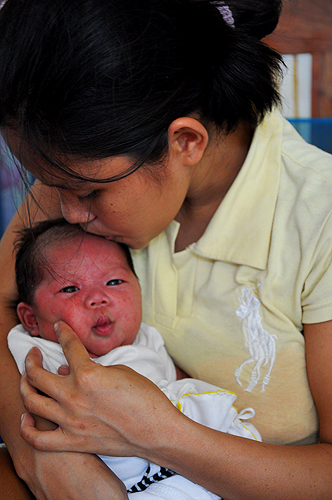Life In Between The Lifeless
Childbirth is emotional enough for everyone involved when it's safe, easy and within the confines of a fully-equipped hospital. When you're delivering your first child while sheltering from the worst storm in history, it is none of those things.
Our colleague in the Philippines, Florence Joy, shares a birth that no one involved will ever forget.

By Florence Joy Malyuo, Development Communication Specialist, World Vision Philippines
From the outside, you would think that this is a normal house. It is made of concrete and sits near other houses.
Going inside, you would notice that the area is divided into two by curtains. From the door, you will see an improvised wooden bed, wooden chairs and scattered leftovers of Typhoon Haiyan like clothes and other kitchen utensils.
Going farther, passing through two curtains of different design and colour, you will see already dried flowers, picture frames and candles on top of two tombs separated by a little space in the middle.
It is then that you would realise that you are inside a mausoleum-turned-temporary house for two families.
“In between these two tombs is where my child was born,” explains Remelyn, 21.
Before the fury
Remelyn is from Batan, Aklan. Her due date was supposed to be 15th November. However, on 8th November, the day Typhoon Haiyan hit Visayas, her struggle started.
“I didn’t feel any pain in the morning. I was fine. We even took some of our things with us in the mausoleum,” she explains.
The morning before the typhoon started to show its fury, the family had already evacuated to the mausoleum.
It was not until 6pm that she started feeling labour pains.
“I knew I was going to give birth but we could no longer go to the hospital because of the fallen trees and electric posts all over,” she recalls. “My husband braved the rain to call for the hilot [traditional birth attendant] instead.”
Between the tombs
Vic, Remelyn’s husband, laid a mat on wood and took it to the space in between the tombs.
“We had no choice but to position her there. We needed something to at least block the wind because it was too cold,” Vic says.
Joining the roaring wind was the deafening shout of Remelyn while fighting the discomforts of giving birth.
“I would inhale, count from 1-10, exhale then push, but the baby wouldn’t come out. I was already hitting Vic to at least ease the pain but to no avail. It was almost unbearable,” she says.
From 6pm to midnight, the family used the light coming from the single motorbike so the hilot can do her work. However, by midnight, the gasoline ran out. Total darkness. They had to use a flashlight.
“I was very worried. What if she won’t make it? What if there is a need to bring her to the hospital? The road was no longer passable and it was too dark. The motorbike was no longer working,” Vic recalls.
“The labour was hard. Blood was coming out from me instead of water and that made it even more painful,” Remelyn says.
 According to Remelyn, there were a lot of times when she would calm down. And the hilot, together with her mother, would steal a bit of sleep on top of the tombs. Even she would feel sleepy, but would wake up when the pain starts to hit her.
According to Remelyn, there were a lot of times when she would calm down. And the hilot, together with her mother, would steal a bit of sleep on top of the tombs. Even she would feel sleepy, but would wake up when the pain starts to hit her.
Princess Yola arrives
“It was at 2am when my baby finally came out. I’m a mother! We were all very happy because of the normal delivery. It was very memorable. I gave birth during the typhoon. And never in my imagination that I saw myself giving birth in between the lifeless,” Remelyn says, looking at her child with much love.
The family decided to name her Princess Yola, coming from the local name of Typhoon Haiyan – Yolanda.
“The following morning, my husband went out to see the extent of the damages caused by the typhoon. It was terrible. I have every reason to hate that day. Our house was destroyed, our things were scattered everywhere. But there’s one thing that covers all those reasons: during Typhoon Yolanda, our princess was born," Remelyn smiles.
They remain grateful. World Vision has distributed food and non-food items in Angas and the family is at peace knowing that they have something to cook in the next days.
“Despite the typhoon, we are still blessed. Like this place,” Vic says. “For me, this is no longer just a place of the dead. This has become our shelter, a place, also for the living.”

Every natural disaster seems to bring with it stories of light and hope. Princess Yola is a beacon from the darkness of Typhoon Haiyan. Thanks to our colleagues in the field - and your support - her family have received the food and water that they need to keep themselves, and their new daughter, safe and alive. What pearl of wisdom would you like to impact to little Yola? Tell us on Facebook.